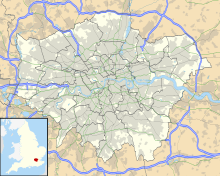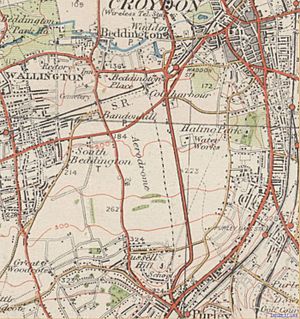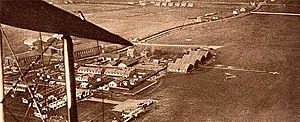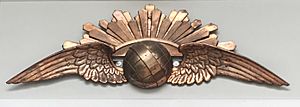Croydon Airport facts for kids
Quick facts for kids
Croydon Airport
|
|||||||||||||||||||
|---|---|---|---|---|---|---|---|---|---|---|---|---|---|---|---|---|---|---|---|
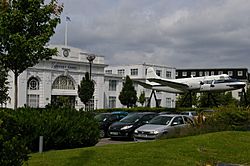 |
|||||||||||||||||||
| Summary | |||||||||||||||||||
| Airport type | Public | ||||||||||||||||||
| Location | Croydon | ||||||||||||||||||
| Opened | 1920 | ||||||||||||||||||
| Closed | 1959 | ||||||||||||||||||
| Coordinates | 51°21′23″N 000°07′02″W / 51.35639°N 0.11722°W | ||||||||||||||||||
| Map | |||||||||||||||||||
| Runway | |||||||||||||||||||
|
|||||||||||||||||||
|
Runway Details:
|
|||||||||||||||||||
Croydon Airport (former ICAO code: EGCR) was the UK's major and only international airport during the interwar period. Located in Croydon, South London, England, it opened in 1920, built in a Neoclassical style, and was developed as Britain's main airport, handling more cargo, mail, and passengers than any other UK airport at the time. Innovations at the site included the world's first air traffic control and the first airport terminal. During World War II the airport was named RAF Croydon as its role changed to that of a fighter airfield during the Battle of Britain; and in 1943 RAF Transport Command was founded at the site, which used the airport to transport thousands of troops into and out of Europe.
After the Second World War, its role returned to civil aviation, but the role of London's primary international airport passed to London Heathrow Airport. Croydon Airport closed in 1959. It had been known under eight different names while it was active.
In 1978, the terminal building and Gate Lodge were granted protection as Grade II listed buildings. In May 2017, Historic England raised the status of the terminal building to Grade II*. Owing to disrepair, the Gate Lodge is now classified as Heritage at Risk by Historic England.
Contents
History
Origin
In December 1915, Beddington Aerodrome was established – one of a number of small airfields around London that were created for protection against Zeppelin airship raids during the First World War. In January 1916, the first two aircraft, B.E 2C's, arrived at the aerodrome as part of Home Defence. Waddon Aerodrome opened in 1918 as part of the adjoining National Aircraft Factory No. 1, to serve aircraft test flights. The two airfields were on each side of Plough Lane (the lane running north from Russell Hill near Purley, in the accompanying old map).
Beddington Aerodrome became a large Reserve Aircraft and Training aerodrome for the Royal Flying Corps. At the end of the First World War the aerodrome was retained, becoming an important training airfield for the newly formed Royal Air Force. During 1919, Prince Albert (later George VI) gained his "wings" here with No. 29 Training Squadron, the first member of the Royal Family to learn to fly. His elder brother, the Prince of Wales (later Edward VIII), also received flying training with No. 29 Training Squadron at Beddington during 1919.
The two aerodromes were combined following the end of the First World War to become Croydon Aerodrome, the gateway for all international flights to and from London. The new aerodrome opened on 29 March 1920 replacing the temporary civil aerodrome at a Cavalry ground on Hounslow Heath. Plough Lane remained a public road crossing the site, and road traffic was halted when necessary, first by a man with a red flag and later by a gate. The aerodrome stimulated a growth in regular scheduled flights carrying passengers, mail and freight, the first destinations being Paris, Amsterdam and Rotterdam. Two flights daily from Paris were scheduled for ease of communication with London during the Paris Peace Conference. In 1923, flights to Berlin Tempelhof Airport began.
Penshurst Airfield was an alternative destination for airliners when Croydon was closed on account of fog. One such diversion was on 24 September 1921, when a de Havilland DH.18 aircraft was diverted to Penshurst. This situation lasted until Penshurst closed on 28 July 1936.
Croydon was the first airport in the world to introduce air traffic control, a control tower, and radio position-fixing procedures. The "aerodrome control tower", 15 ft (4.6 m) high with windows on all four sides, was commissioned on 25 February 1920 and provided basic traffic, weather and location information to pilots.
On the formation of Britain's first national airline, Imperial Airways, on 31 March 1924, Croydon became the new airline's operating base. Imperial Airways was the British Government's chosen instrument to develop connections with the U.K.'s extensive overseas interests. It was therefore from Croydon that Britain first developed its European and longhaul routes to India, Africa, the Middle and Far East, Asia, Africa and Australia (in conjunction with Qantas).
Following the Imperial Airways de Havilland DH.34 crash of December 1924, Britain's first major civil aviation accident, conditions at Croydon came under criticism from the public inquiry that investigated the causes. The inquiry was Britain's first into an aviation accident which led to an Act of Parliament, the Croydon Aerodrome Extension Act 1925. The Croydon Aerodrome Extension Act led to large scale expansion, redevelopment and construction of an improved new airport with airport buildings constructed adjacent to the Purley Way, Croydon.
Expansion
Under the provisions of the Croydon Aerodrome Extension Act 1925, the airport was greatly enlarged between 1926 and 1928, with a new complex of buildings being constructed alongside Purley Way, including the first purpose-designed airport terminal and air traffic control tower, the world's first airport hotel, and extensive hangars. The development cost £267,000 (£11.5 million in today's prices) . Plough Lane was closed permanently to let heavier airliners land and depart safely. The airport's terminal building and control tower were completed in 1928, and the old wooden air traffic control and customs building demolished. The new buildings and layout began operations on 20 January 1928, and were officially opened on 2 May 1928 by Lady Maud Hoare.
Croydon was where regular international passenger services began, initially using converted wartime bombers, and the Croydon–Le Bourget route soon became the busiest in the world. Air traffic control was first developed here, as was the "Mayday" distress call. Amy Johnson took off from Croydon on 5 May 1930 for her record-breaking flight to Australia. In 1927, Charles Lindbergh arrived in Spirit of St. Louis, to be greeted by an enthusiastic crowd of over 100,000 people. Winston Churchill also took flying lessons.
On the morning of 11 July 1936, Major Hugh Pollard, and Cecil Bebb left Croydon Airport for the Canary Islands in a de Havilland Dragon Rapide aircraft, where they picked up General Francisco Franco, taking him to Spanish Morocco and thereby helping to trigger the outbreak of the Spanish Civil War.
Imperial Airways used the Handley Page HP42/HP45 four-engined biplanes from Croydon, and the Armstrong Whitworth Atalanta, which was the first monoplane airliner used by the airline, intended for use on the African routes. In March 1937 British Airways Ltd operated from Croydon, moving to Heston Aerodrome in May 1938. Imperial Airways, serving routes in the British Empire, and British Airways Ltd, serving European routes, were merged by the Chamberlain government in November 1938 to become British Overseas Airways Corporation (BOAC). Larger four-engined monoplanes, Armstrong Whitworth Ensign series (G-ADSR) came into service that year.
The airport also hosted a much-publicised visit by Gertrud Scholtz-Klink, leader of the National Socialist Women's League (NS-Frauenschaft) and rumoured to be a spy; historians have speculated that she landed in Britain to cultivate Germans spies living here, in the run-up to WWII.
When the Second World War started in September 1939, Croydon Airport was closed to civil aviation but played a vital role as a fighter station during the Battle of Britain. No. 92 Squadron flew Supermarine Spitfires from RAF Croydon during the early part of the Second World War and the Battle of Britain.
Battle of Britain
On 15 August 1940, Croydon Airport was attacked in the first major air raid on the London area. At around 6.20 pm 22 Bf 110 and Bf 109 fighter-bombers of Erpr.Gr.210 mounted a final raid of the day, intended for RAF Kenley nearby, but attacked Croydon (four miles further north) in error. The armoury was destroyed, the civilian airport terminal building was badly damaged, and a hangar was damaged by cannon fire and blast. Another hangar and about forty training aircraft in it went up in flames. Six airfield personnel died (four airmen from No. 111 Squadron, an officer of No. 1 Squadron RCAF, and a female telephonist from Station HQ). Factories next to Croydon Airport took the worst of the bombing. The British NSF factory (making electrical components) was almost entirely destroyed, and the Bourjois perfume factory gutted. The Rollason Aircraft factory also received bomb hits and accounted for many of the 62 civilians (including five women) killed and 192 injured. Eight of the attacking aircraft were shot down by the Hurricanes of 32 and 111 Squadrons.
Croydon became the base of RAF Transport Command in 1944.
Present day
Much of the site has been built over, but some of the terminal buildings near Purley Way (the A23 road) are still visible, clearly identifiable as to their former purpose. The former terminal building is called Airport House, and the former control tower houses a visitors' centre.
A de Havilland Heron (a small propeller-driven British airliner of the 1950s) is displayed on the forecourt outside Airport House, mounted on struts. The Heron is painted to represent an example registered G-AOXL of Morton Air Services, the aircraft that flew the last passenger flight from Croydon on 30 September 1959. A memorial to those lost in the Battle of Britain stands slightly to the south.
Although Croydon has long ceased operation, the two cut ends of Plough Lane have never been reunited, but the area between has been developed instead into parkland, playing fields, and the Roundshaw residential estate with its roads aptly named after aviators and aircraft. All that remains of the runways is a small area of tarmac about 400 feet (120 m) long each way in Roundshaw Park just west of Purley Way, which is a remnant of the WNW-ESE runway due south of the control buildings; it can be seen at 51°21′04″N 0°07′03″W / 51.351067°N 0.117449°W; the "arm" may be a remnant of a taxiway to Hangar B. The area is used primarily by walkers, model aircraft enthusiasts, locals playing football and the Croydon Pirates baseball team.
The church on the Roundshaw estate has a cross on its outside wall that was made from the cut down propeller of a Spitfire based at Croydon during the Second World War.
The area is still known as Croydon Airport for transport purposes and was the location for Croydon Water Palace.
In recognition of the historical significance of the aerodrome, two local schools (Waddon Infants School and Duppas Junior School) merged in September 2010 and became The Aerodrome School.
The buildings
The Aerodrome Hotel and the terminal building including its grand booking hall were built in the neo-classical geometrical design typical of the early 20th century. A further item that would have caught the eye of visitor and traveller alike was the time zone tower (now lost) in the booking hall with its dials depicting the times in different parts of the world. Croydon Airport's Aerodrome Hotel is part of Croydon Vision 2020 regeneration plan.
The Airport Hotel survives as the independent Hallmark Hotel.
Events and celebrities
| Date/year | Aviator | Comments |
|---|---|---|
| 1919 | Winston Churchill | Took extensive flying lessons at Croydon and was nearly killed during a crash at take-off in 1919. |
| 1925 | Alan Cobham | Flew from Croydon to Cape Town and back in 1925-6 |
| 1927 | Charles Lindbergh | Flew into Croydon in 1927 shortly after completing the first solo trans-Atlantic flight |
| 1928 | Mary Bailey | Flew solo from Croydon to Cape Town in 1928. |
| 1928 | Mary, Lady Heath | The first pilot to fly a small open-cockpit aircraft from Cape Town to London, Croydon Aerodrome.18 May 1928 |
| 1928 | Bert Hinkler | Made the first flight from Croydon to Darwin, Australia in 1928 |
| 1928 | Charles Kingsford Smith | Beat Hinkler's record |
| 1929 | Armstrong Whitworth | flew an Argosy from Croydon to Paris, Douglas Fairbanks and Mary Pickford met Edwina Mountbatten, Countess Mountbatten of Burma in 1929. |
| 1930 | Aspy Engineer and R. N. Chawla | First Indians to fly from Karachi to Croydon and shortly after, Engineer flew from Croydon to Karachi solo and within the specified one month time frame to win the Aga Khan competition in 1930. |
| 1930 | Man Mohan Singh | The first Indian to fly Croydon to Karachi in 1930 as a contestant in the Aga Khan competition. |
| 1930 | Amy Johnson | The first woman to fly from Croydon to Australia, later to return to Croydon to a jubilant welcome. She left Croydon 5 May 1930 with a few people to see her off. She returns from Australia to be greeted by crowds of thousands. |
| 1934 | Tom Campbell Black | With C. W. A. Scott won the MacRobertson London to Melbourne Air Race |
| 1936 | Juan de la Cierva | The Spanish inventor of the autogyro, who died in an aviation accident on 9 December 1936 |
Immigration and customs
The Chief Immigration Officer of the shipping port of Port of Dover, P. L.Hartley, took over in 1936.
Medical provision
A medical officer, Dr John Robert Draper, M.B., B.Ch., was employed by Croydon Council to take over medical duties at the airport from 1 January 1931. He was answerable to Croydon's Medical Officer of Health. Following the Public Health (Aircraft) Regulations 1938, his role changed significantly.
Images for kids
See also
 In Spanish: Aeropuerto de Croydon para niños
In Spanish: Aeropuerto de Croydon para niños


